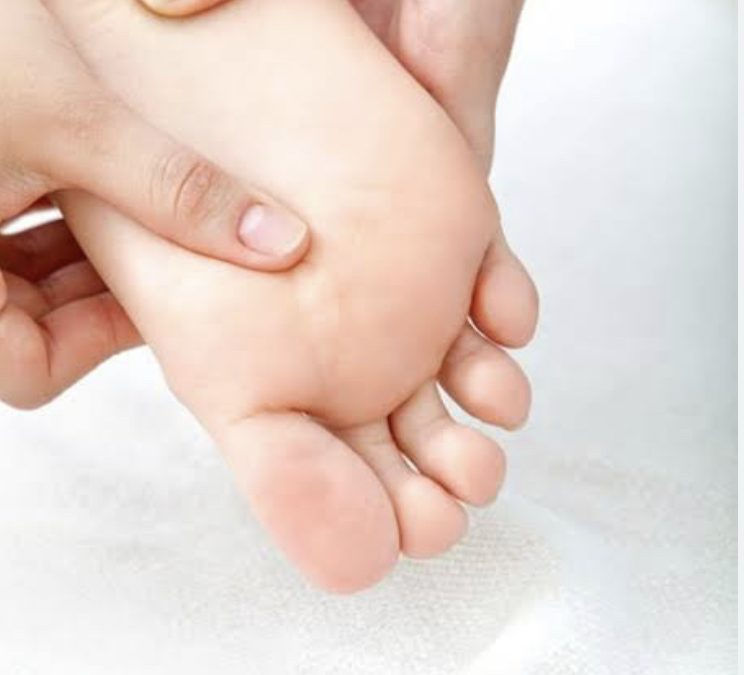Do I Have A Heel Spur or Plantar Fasciitis?
- Dr. Angela Walk

- Jun 22
- 4 min read
Updated: Jun 25

Do you wake up with sharp heel pain with your first steps out of bed? You may wonder: Is it a heel spur or plantar fasciitis?
I specialize in plantar fasciitis and I have seen thousands of cases. One of the most common points of confusion I see among patients is the difference between heel spurs and plantar fasciitis.
These conditions often share similar symptoms, but they are distinct in cause, diagnosis, and treatment.
Let’s clear up the confusion—and help you understand the true cause of your heel pain.
Heel Spur vs. Plantar Fasciitis: What’s the Difference?
The key difference is this:
Heel spurs are bony growths (calcium deposits) that form on the heel bone.
Plantar fasciitis is the degeneration or breakdown of the soft tissues in the foot, the plantar fascia, the thick connective tissue that supports your arch.
Interestingly, heel spurs often don’t cause pain at all, while plantar fasciitis almost always does. That’s why getting an accurate diagnosis is crucial.
Location of Pain
Plantar fasciitis pain is typically on the inside of the heel and along the arch of the foot.
Heel spur pain tends to be more centralized on the bottom of the heel, often with a dull ache or stabbing pain throughout the day.
Symptoms at a Glance
Plantar Fasciitis Symptoms:
Sharp, burning pain on the inside of the heel or arch—especially first thing in the morning
Pain after long periods of sitting or inactivity
Discomfort when stretching the foot or extending the big toe
Increased pain post-exercise or prolonged standing
Heel Spur Symptoms:
Localized stabbing pain in the center of the heel
A dull ache that worsens throughout the day
Increased pain when walking barefoot or on hard surfaces
Confirmed via X-ray (spurs may measure up to ½ inch)
Do Heel Spurs Actually Cause Heel Pain?
Not always. In fact, according to the American Academy of Orthopedic Surgeons, only 1 in 20 people with heel spurs experiences pain.
Heel spurs are often incidental findings—visible on X-ray, but not the source of your symptoms.
Most heel pain is caused by plantar fasciitis, which creates pain where the fascia connects to the heel, even if a spur is also present.
Important note: You can have plantar fasciitis without a heel spur—and vice versa.
Can Heel Spurs Cause Plantar Fasciitis?
No—this is a common misconception. Studies (including cadaveric research) show the plantar fascia does not attach to the heel spur itself.
Painful heel spurs and plantar fasciitis are often coincidental, but one does not cause the other.
What Causes These Conditions? (And What You Can Do About It)
Heel spurs and plantar fasciitis share many of the same risk factors:
1. Limited Ankle Mobility & Tight Calves
Restricted dorsiflexion (pulling your foot toward your shin) is often caused by tight calf muscles.
When your ankles are limited in motion, it alters your gait, and causes the foot to overpronate.
This creates added stress on and excess tension on the plantar fascia and heel.
Solution:
The best way to increase flexibility in your calf and ankles is to perform calf raises to strengthen and lengthen the gastroc/soleus complex.
For added challenge, place a ball between the heels to target arch-stabilizing muscles.focus on strengthening with with calf raises
2. Fascial Adhesions
Adhesions in the fascia around the calf, ankle, or plantar fascia restrict movement and alter mechanics. This causes further irritation and inhibits healing.
Solution:
Use a stainless steel tool every 2 days to perform myofascial release on the lower leg, ankle, and arch.
This improves tissue glide, reduces tension, and enhances the effectiveness of loading exercises.
3. Improper Footwear
Most modern shoes—especially athletic and dress shoes—are tapered at the toe and elevated at the heel, which alters foot mechanics and weakens your arch.
Solution:
Transition to functional footwear that features:
A wide toe box
Zero drop heel (flat from heel to toe)
Flexible sole that mimics barefoot movement
Wearing natural footwear encourages proper foot splay, better load distribution, and stronger arch mechanics.
Need help choosing the right shoes? Check out my Approved Shoe List for plantar fasciitis.
4. Weak Intrinsic Foot Muscles
The small muscles in your foot (the intrinsics) help support your arch and absorb shock. If they’re weak, other structures—like the plantar fascia—take on the load.
Solution:
Incorporate foot strengthening into your daily routine:
Toe splaying
Short foot exercises
Arch doming drills
These movements help your feet do their job—without relying on artificial support or overloading the fascia.
You can find these exercises and more in my free guide where I show you the exact steps to resolve plantar fasciitis at home.
7. Sudden Activity Changes or Repetitive Stress
Starting a new high-impact activity, suddenly increasing your mileage, or long days on your feet can irritate or overload the heel.
Solution:
Train gradually.
Listen to your body.
Focus on long-term strength and mobility.
In Summary: How to Tell the Difference
Symptom | Plantar Fasciitis | Heel Spur |
Morning Pain | ✅ Sharp, stabbing | ✅ Dull or stabbing |
Pain Location | Arch, inside heel | Center heel |
X-Ray Diagnosis | No | Yes |
Always Causes Pain | ✅ Yes | ❌ Not always |
Best Treatment | Progressive loading, mobility, footwear changes | Often no treatment needed unless painful |
Final Thoughts from Dr. Angela
Heel spurs and plantar fasciitis may seem similar, but they are not the same—and treating them requires understanding the difference.
In nearly every case of heel pain I treat, plantar fasciitis is the true culprit, and the solution lies in:
Progressively loading the tissue
Correcting foot mechanics
Strengthening your foundation
You don’t need to rely on orthotics or cortisone shots. You just need the right strategy—and consistency.
You’ve got this,
Dr. Angela Walk
The Plantar Fasciitis Doc

➡️ Work With Me







Comments